Earlier this month was held the ‘End-TB Summit’ in New Delhi and prime minister Narendra Modi re-launched the ministry of health and family welfare (MoHFW) “cough”, a national mass media campaign that warns citizens that TB and tobacco are a deadly combination with tobacco the agency behind TB. A report, for Different Truths.
Marshal Wyatt Earp and Doc Holliday. Two of the American Wild West’s real-life heroes. Wyatt tamed Dodge City and Deadwood and went on to Tombstone to clear it off the riffraff and the Cowboy Gang. The Gunfight at the Okay Corral set the tone for the Cattlemen’s War and marked Earp’s as the toughest law enforcer of the time. Wyatt met Doc Holliday in Tombstone and there developed a special bond between them. But death rode on Doc’s shoulder and death ate into his lungs. Doc was too quick on the draw to be killed by the bullet. That was left to ‘Consumption’ or what we know as TB, today. TB killed ‘Doc’ as sure as it did 4,32,000 Indians in 2016 alone.
Earlier this month was held the ‘End-TB Summit’ in New Delhi and prime minister Narendra Modi re-launched the ministry of health and family welfare (MoHFW) “cough”, a national mass media campaign that warns citizens that TB and tobacco are a deadly combination with tobacco the agency behind TB. Tobacco consumption and exposure to second-hand tobacco smoke increase the risk of TB. A key barrier to timely diagnosis and treatment among smokers is the assumption that a wracking cough they have because of cigarette and bidi and not because it could be TB.
The ‘cough’ campaign encourages smokers to visit their doctor to confirm whether a persistent cough is a sign of TB. Data show that on an average more than 1,183 people die of TB every day. The government of India has vowed to eradicate TB by 2025, five years ahead of the global TB elimination target of 2030. The campaign was designed to create support for TB eradication, encourage smokers to quit, and increase timely diagnosis and treatment of TB.
“Most TB deaths in India occur among young, economically productive adults and the disease is one of the top five causes of death among people aged 30-69 years,” says José Luis Castro, president and chief executive officer, Vital Strategies, which designed the campaign. “India’s tobacco epidemic is contributing to this burden. “cough” will support progress towards the target of eliminating TB by 2025 by encouraging smokers to quit and ensuring that smokers and those exposed to second-hand smoke visit the doctor about a persistent cough. This is a life-saving message and we congratulate MoHFW on the re-launch of this important campaign.”
When “cough” first launched on World No Tobacco Day in 2017, India was the first country to run a national tobacco control campaign that highlighted the increased risk of TB and dying from TB linked to smoking tobacco or exposure to second-hand smoke. The public service announcement (PSA) graphically shows that while a smoker’s cough tells the smoker they have a health problem, a persistent cough over two weeks or more could indicate that the problem is TB. The PSA shows a father smoking and coughing beside his daughter, noting that exposure to second-hand smoke brings the same risks. It ends with the stark warning that “Every bidi cigarette brings you and those around you closer to TB.”
To ensure pan-India reach, “cough” is broadcast in 17 languages in mass media and on major digital platforms such as YouTube, Facebook, Hotstar, and Voot. In advance of its initial launch in 2017, “cough” was rigorously pretested with a target audience who found that it was ‘easy to understand’, ‘believable’, ‘made respondents stop and think’, and ‘made respondents feel more concerned’ about smoking around others. The PSA also made respondents ‘feel sympathetic to those with TB’, ‘made them feel concerned about symptoms of TB’, ‘made them more likely to visit a doctor if they had TB symptoms,’ and ‘increased their confidence to take TB medications if they got sick. Overall, respondents understood the main message of the PSA and it resonated well with them.
Here are some facts about the TB epidemic that should make people pause.
- TB is the ninth leading cause of death worldwide and the leading cause from a single infectious agent, ranking above HIV/AIDS
- In 2016, there were an estimated 1.3 million TB deaths among HIV-negative people (down from 1.7 million in 2000) and an additional 3,74, 000 deaths among HIV-positive people
- An estimated 10.4 million people fell ill with TB in 2016: 90% were adults, 65% were male, 10% were people living with HIV (74% in Africa) and 56% were in five countries: India, Indonesia, China, the Philippines, and Pakistan
- Drug-resistant TB is a continuing threat. In 2016, there were 6,00,000 new cases with resistance to rifampicin (RRTB), the most effective first-line drug, of which 4,90,000 had multidrug-resistant TB (MDR-TB). Almost half (47%) of these cases were in India, China, and the Russian Federation
- In 2016, 6.3 million new cases of TB were reported (up from 6.1 million in 2015), equivalent to 61% of the estimated incidence of 10.4 million; the latest treatment outcome data show a global treatment success rate of 83%, similar to recent years
- Ten countries accounted for 76% of the total gap between TB incidence and reported cases; the top three were India (25%), Indonesia (16%) and Nigeria (8%)
- Broader influences on the TB epidemic include levels of poverty, HIV infection, under-nutrition and smoking. Most high TB burden countries have major challenges ahead to reach SDG targets related to these and other determinants.
And here are some facts about the tobacco epidemic
- Tobacco kills more than 7 million people each year. More than 6 millions of those deaths are the result of direct tobacco use while around 8,90,000 are the result of non-smokers being exposed to second-hand smoke
- Around 80% of the world’s 1.1 billion smokers live in low- and middle-income countries
- Tobacco kills up to half of its users
- Second-hand smoke is the smoke that fills restaurants, offices or other enclosed spaces when people burn tobacco products such as cigarettes, bidis, and water-pipes
- There are more than 4,000 chemicals in tobacco smoke, of which at least 250 are known to be harmful and more than 50 are known to cause cancer
- In adults, second-hand smoke causes serious cardiovascular and respiratory diseases, including coronary heart disease and lung cancer. In infants, it causes sudden death. In pregnant women, it causes low birth weight
- Almost half of the children regularly breathe air polluted by tobacco smoke in public places
- Second-hand smoke causes more than 8,90,000 premature deaths per year.
‘Doc’ Holliday died more than a century ago. He was not a smoker but he was a heavy drinker and it was believed at the time that alcohol killed him. Holliday was known as ‘Doc’ because he was a qualified doctor but at that time not even doctors knew enough about the disease called ‘Consumption’ and its links with tobacco consumption. True, patients were advised mountain air and many went to the Pines to get a cure. That was it. TB alias ‘Consumption’ remains a killer-disease, slow on the draw but a killer nevertheless.
Aditya Aamir
©IPA Service
Photos from the Internet





 By
By
 By
By
 By
By
 By
By